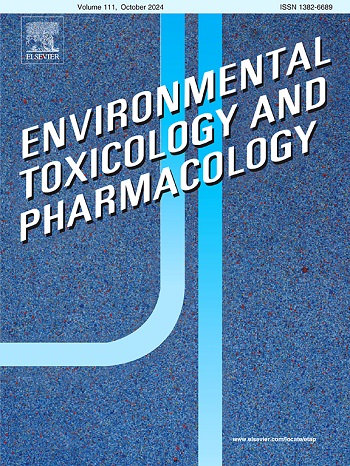Environmental assessment of steroid endocrine disruptors in stranded cetaceans: A methodological approach to detection and analysis
IF 4.2
3区 环境科学与生态学
Q2 ENVIRONMENTAL SCIENCES
引用次数: 0
Abstract
Exploring the presence of endocrine disrupting compounds in marine organisms, particularly cetaceans, is crucial to evaluate contamination within the ocean's food web and the detection of synthetic hormones in cetaceans is a strong indication of anthropogenic pollution in marine ecosystems. Due to their characteristics, blubber samples are a key component in assessing the analysis of cetaceans, but this type of sample require precise and sensitive analytical methods. Despite some methodologies have been developed for the analysis of natural steroid hormones in cetacean blubber, a significant gap persists in the comprehensive analysis of synthetic steroids within these samples. In this work, a QuEChERS (Quick, Easy, Cheap, Effective, Rugged, and Safe) extraction combined with UHPLC-MS/MS (ultra-high-performance liquid chromatography with tandem mass spectrometry) analysis was performed to determine six synthetic steroid hormones (nandrolone, prednisolone, prednisone, megestrol acetate, norethisterone, and norgestrel) in 11 stranded cetacean blubber samples. Despite the complex nature of blubber samples, the developed methodology showed promising results, with recoveries ranging from 70 % to 120 % for most target compounds at low concentration levels (150 ng·g−1). The method demonstrated high precision with relative standard deviations under 20 % in both intra- and inter-day experiments. Regarding the matrix effect, ion suppressions of about 50 % were also calculated for those samples spiked at concentration levels of 150 ng·g−1, nevertheless, all compounds were still able to be detected, in most cases below quantification limits. Notably, one sample presented a quantified concentration of megestrol acetate, a steroid hormone used in contraceptives and cancer treatments, at 26.98 ± 2.62 ng·g−1. The results affirm the methodology's effectiveness for analyzing synthetic steroid hormone levels in cetacean blubber, providing a valuable tool for assessing environmental concentrations of these anthropogenic endocrine disruptors and their impact on cetacean welfare and conservation.
搁浅鲸类中类固醇内分泌干扰物的环境评估:检测和分析的方法学方法
探索海洋生物,特别是鲸类动物中内分泌干扰化合物的存在,对于评估海洋食物网中的污染至关重要,在鲸类动物中检测到合成激素是海洋生态系统受到人为污染的有力迹象。由于鲸脂的特性,鲸脂样本是评估鲸类动物分析的关键组成部分,但这种类型的样本需要精确和敏感的分析方法。尽管已经开发了一些方法来分析鲸类鲸脂中的天然类固醇激素,但在这些样本中的合成类固醇的综合分析方面仍然存在重大差距。采用QuEChERS (Quick, Easy, Cheap, Effective, Rugged, and Safe)萃取法联合超高效液相色谱串联质谱(UHPLC-MS/MS)分析了11份搁浅鲸脂样品中的6种合成类固醇激素(诺龙、强的松龙、强的松、醋酸甲地孕酮、去甲睾酮和去甲孕酮)。尽管鲸脂样品性质复杂,但所开发的方法显示出有希望的结果,在低浓度水平(150 ng·g−1)下,大多数目标化合物的回收率在70 %至120 %之间。该方法在日间和日间实验中均具有较高的精密度,相对标准偏差在20 %以下。对于基质效应,在浓度为150 ng·g−1的样品中也计算出约50% %的离子抑制,然而,所有化合物仍然能够被检测到,在大多数情况下低于定量限。值得注意的是,一份样品的醋酸甲地孕酮(一种用于避孕和癌症治疗的类固醇激素)的定量浓度为26.98 ± 2.62 ng·g−1。结果证实了该方法对分析鲸脂中合成类固醇激素水平的有效性,为评估这些人为内分泌干扰物的环境浓度及其对鲸类福利和保护的影响提供了有价值的工具。
本文章由计算机程序翻译,如有差异,请以英文原文为准。
求助全文
约1分钟内获得全文
求助全文
来源期刊
CiteScore
7.00
自引率
4.70%
发文量
185
审稿时长
34 days
期刊介绍:
Environmental Toxicology and Pharmacology publishes the results of studies concerning toxic and pharmacological effects of (human and veterinary) drugs and of environmental contaminants in animals and man.
Areas of special interest are: molecular mechanisms of toxicity, biotransformation and toxicokinetics (including toxicokinetic modelling), molecular, biochemical and physiological mechanisms explaining differences in sensitivity between species and individuals, the characterisation of pathophysiological models and mechanisms involved in the development of effects and the identification of biological markers that can be used to study exposure and effects in man and animals.
In addition to full length papers, short communications, full-length reviews and mini-reviews, Environmental Toxicology and Pharmacology will publish in depth assessments of special problem areas. The latter publications may exceed the length of a full length paper three to fourfold. A basic requirement is that the assessments are made under the auspices of international groups of leading experts in the fields concerned. The information examined may either consist of data that were already published, or of new data that were obtained within the framework of collaborative research programmes. Provision is also made for the acceptance of minireviews on (classes of) compounds, toxicities or mechanisms, debating recent advances in rapidly developing fields that fall within the scope of the journal.

 求助内容:
求助内容: 应助结果提醒方式:
应助结果提醒方式:


